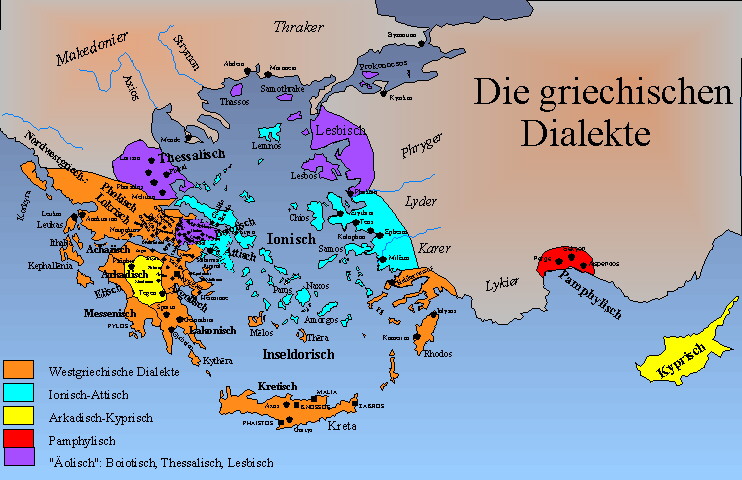Seeing History
DistinctionsOne needs to make distinctions. Suppose we are talking about the Genius of Greece. What people tend to extol under that title is more likely to be the Genius of Athens, or even the Excellence of Art History Under Pericles. If, while not losing sight of this or that admirable statue by Praxelites, we also look out of the corner of our eye at the Athenian small farmer, or the Spartan adolescent, or the Thracian buccaneer, and there is really no reason why we should not, our picture becomes a little more complicated. It also takes on a certain reality, and reality is a plus. We get that plus by recognizing Distinctions in the data set.
Reality can be hard to handle, but handling it is part of the job. The first question to ask is: How many things are we really dealing with here? If a text, is it simple or composite? If a civilization, is this trait characteristic of all of it?
Did the Greeks all speak Greek? We might have thought so, but the experts draw a more complicated map - a map that already makes interesting historical suggestions. And which it may be useful to keep in mind when noting the pattern of Greek alliances, or the pattern of acceptance of certain Greek literary and artistic fashions.
It is also common to speak of "China" in the years before 0221, but probably the single most important fact about those years is that there was no China, rather, a mix of Sinitic and non-Sinitic states engaged in a showdown power struggle, which finally led to the unified Chin Empire only after millions of people had been killed, and not all those people even spoke the same language. Among the great powers of the Warring States period, which was also the great age of Chinese philosophy, Chu in the south, and Wu and Ywe in the east, were not originally Sinitic in culture; they had other affinities. Millennia of homogenization have now reduced those differences, but not eliminated them. Even at the present, a "dialect" map of China will still show some of the old culture division lines.
A famous linguist at one of our conferences referred at one point to Chu in this period as "another part of the country." We are still in shock. What country?
Economic simplicities too may sometimes change under close scrutiny. Those who deal with the American Civil War period are accustomed to the thought that, in the prewar South, "cotton was king." The foreign policy of the South was in large part based on that perception. So was the private agenda of every trader who followed the Northern armies into cotton country. It is unlikely to emerge from any future research that cotton was neglible. But was it actually king? Forrest McDonald and his colleague Grady McWhiney began to wonder. McWhiney had been looking into differences between northerners and southerners, and . . .
. . . along the way he came across an interesting datum that had been neglected in conventional works on the South: the region raised enormous quantities of livestock, especially hogs. . . . Each year, in late summer, enormous herds of animals were rounded up and driven long distances to market. Moreover, a goodly number of tillage farmers raised Indian corn as their cash crop, the corn being sold to herdmen along their routes to market. Indeed, the routes were sprinkled with "hog hotels," established solely to service the hog and cattle drives . . .
. . . We published our first article in the Journal of Southern History; it was entitled "The Antebellum Southern Herdsman: A Reinterpretation." We pointed out that livestock raising was a massive enterprise, the value of southern livestock in 1860 having been more than twice as great as the value of the cotton crop.
If one's understanding of the American South is to be something more than a catchphrase or a bumpersticker, new information like this will somehow have to be worked into it. And into one's book about it, and perhaps eventually (one never knows) into undergraduate perceptions of it.
Handling Divisions
One way to handle these differences is to have categories into which facts about them can be put. You need a map before you can record dialect data, and you need a ledger before you can enter cash value. Once you have information organized this way, certain analytical procedures become obviously relevant. Just which ones become relevant will depend on the kind of data you have. The data in the above examples is geographical or numerical; such situations lend themselves to graphic representation.
So do some seemingly less tangible ones.
Suppose you are working on a certain ancient philosopher, who is famous for Concept C. Plot C among the works of that philosopher, and arrange those works in chronological order. Is C a constant element of your philosopher's thought? Is it an early enthusiasm later abandoned or modified into something else? Is it exclusively a notion of the philosopher's maturity? Whole volumes have been written on the concept of Li (propriety, ritual behavior) in Sywndz, the most eminent name in Chinese philosopher on the eve of Empire, without so much as hinting at this question, let alone answering it.
Or again, there is an early Christian text called the Didache, which includes what is called the Two Ways tract. Parts of that tract, conventionally numbered as Didache 2-4, occur also in Section 19 of the Epistle of Barnabas, but in different order, and with both additions and omissions. Which of those versions is earlier, and what is the meaning of the differences? That is an obvious question, but how to we proceed to answer it? For a start, we might ask, exactly what are the differences? There is an exceedingly simple way to make them plain to the eye and the understanding. If you take a copy of each, and highlight in green in Barnabas those lines which occur in Didache 2, in fuchsia those in Didache 3, and in orange those in Didache 4, then at the end of the half hour, ignoring small differences, your copy of the first half of Barnabas 19 will look something like this:
19:1. The Way of Light, then, is as follows, and whoever desires to make his way to the appointed place must be actively at work. Now, the knowledge granted us to enable us to walk in this way embraces the following points: [2] Love your Maker; reverence your Creator; glorify Him who ransomed you from death; be single of heart and exuberant of spirit; do not associate with such as walk in the Way of Death; abhor everything not pleasing to God; detest every form of hypocrisy; do not by any means neglect the commandments of the Lord. [3] Do not carry your head high, but be ever in a humble frame of mind; do not reach out for personal glory; do not plot evil against your neighbor; do not open your heart to presumption. [4] Do not fornicate; do not commit adultery; do not practice pederasty; do not let the Word of God escape your lips in the presence of any that are impure. Make no distinction between man and man when correcting anyone's transgression. Be gentle; be quiet; with trembling treasure the instructions you have received. Do not bear malice against your brother. [5] Do not waver in your decision. Do not take the name of the Lord in vain. Love your neighbor more than yourself. Do not kill a fetus by abortion, or commit infanticide. Do not withdraw your hand from your son or your daughter, but from their youth teach them the fear of God. [6] Do not covet your neighbor's goods; do not be greedy. Do not be on intimate terms with the powerful, but associate with holy and lowly folk. Accept as blessings the casualties that befall you, assured that nothing happens without God. [7] Do not be double-minded or double-tongued, for the double tongue is a deadly snare. In reverence and fear be submissive to your masters as representatives of God. Do not when embittered give orders to your slave, male or remale, for they hope in the same God; otherwise, they might lose the fear of God, who is the Master of you both. . . .
The rest of Barnabas 19 is either blank [without Didache counterpart] or orange.
It will at once be seen that the first two sections of Didache [Didache 2, green; Didache 3, fuchsia] have here been mixed with each other and inserted, together with new material, into the third section of Didache [orange]. What was in Didache a well marked set (first commandments, then expositions, and finally community living advice) is in Barnabas blended into a continuous homily on good conduct in general. Sometimes the principles of association in Barnabas are amusing. In [5], for instance, it seems that the commandment against infanticide in Didache 2 has reminded the Barnabas writer of the maxim about child raising in Didache 4, and he has joined them accordingly. In such revealing moments, the directionality of the relationship becomes clear. The Barnabas version is a remix of the Didache version, and not vice versa.
There are substantive indications that work the same way. The Didache version of the Two Ways document contains no explicit reference to Christian beliefs. It might be, and by many scholars it is thought to have been, originally an expression of Jewish piety. The Dead Sea Scrolls, from the library of an undeniably Jewish community, parts of which are very close to parts of the Didache, provide evidence that this is correct. But a passage in Barnabas Section [2], which has no parallel in the Didache, namely "He who ransomed you from death," clearly refers to the death of Jesus as atoning for the sins of all mankind. Barnabas has not only stirred its Didache source into a general homily on right conduct; it has Christianized that homily. Another sign of this tendency is the admonition in Barnabas [4], not to let the Word of God be mentioned in the presence of outsiders. The Christian communities envisioned in Barnabas are more separate from the life around them than are the communities, whether Jewish or Christian, implied in the Didache.
There is much more here. But this much will suffice for purposes of illustration. In such ways can anyone with a copy of the text and two or three highlighters and an hour of time establish the directionality between two related texts, and in the process become more closely aware of what is taking place between the time of the one, and the time of the other.
We began this page with a color map, and we have ended with a color map. Each map helps organize data, whether on the scale of a whole civilization or on the scale of a couple of paragraphs; data whose distribution and arrangement would be hard to envision without the map. But whether with such conveniences or by brute mental force, one needs somehow to be aware of the distribution of the data, and before that, to be aware of the categories into which the data is distributed. Aeolic or Arcadian, wealth or poverty, hogs or cotton, a phrase repeated or not repeated in another text; whatever. In the difference lies the history.
Readings
- Forrest McDonald. Recovering the Past: A Historian's Memoir.
17 Dec 2006 / Contact The Project / Exit to Outline Index Page


